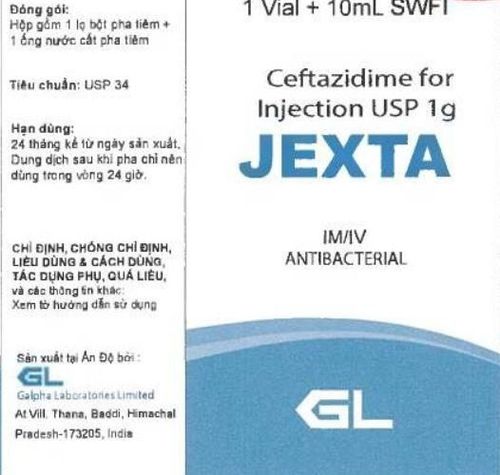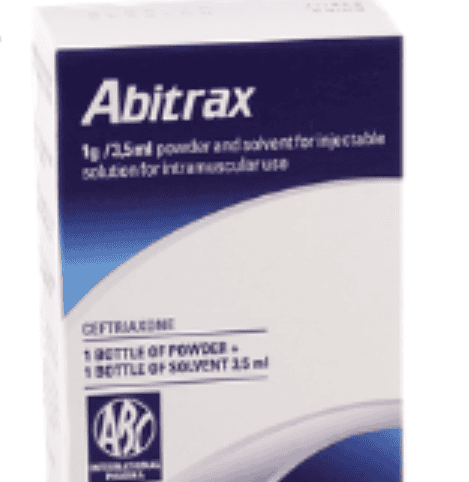This is an automatically translated article.
Marksanscef is an antibiotic used in infections such as meningitis, urinary tract infections, syphilis, pneumonia,... Marksanscef is administered by injection with a dose of 1g Ceftriaxone in each dose. Find out with Vinmec the effects of Marksanscef as well as the notes when using the drug right here in the article below.
1. What is Marksanscef?
Marksanscef is an antibiotic for parenteral use with the main active ingredient being Ceftriaxone. Marksanscef is a 3rd generation cephalosporin antibiotic. Each dose of Marksanscef will include 1 vial of powder containing 1g of Ceftriaxone and 500mg of Sulbactam sodium.2. Uses of the drug Marksanscef
The use of Marksanscef depends on the active ingredient Ceftriaxone, a 3rd generation cephalosporin antibiotic with a broad spectrum of antibacterial activity against Gram-negative and Gram-positive bacteria.With parenteral administration, the absorption of Ceftriaxone into the body and distribution to tissues and fluids occurs rapidly. According to the manufacturer's regulations, Marksanscef is used in 2 ways, intramuscularly or intramuscularly, of which intramuscular injection has 100% bioavailability.
Ceftriaxone antibacterial by inhibiting the cell wall synthesis of bacteria, making newly born bacteria unstable in the body and easy to destroy. In addition, with the presence of Sulbactam sodium in the composition, the antibiotic Marksanscef is more stable in the environment with beta lactams of pathogenic bacteria.
Marksanscef's broad spectrum of antibacterial activity on anaerobic, aerobic, Gram-negative and Gram-positive bacteria makes the drug used in the treatment of many infections in different regions and organs.
Marksanscef antibiotic by injection is indicated in the following cases
Treatment of meningitis Treatment of Lyme disease (disease transmitted by fleas living on deer - deer to humans) Treatment of urinary tract infections Treatment Treatment of pneumonia Treatment of bone and joint infections, skin infections Prophylaxis of infections in endoscopic surgery (vaginal, abdominal surgery) Each antibiotic line always has contraindications in some cases determined. With the antibiotic Marksanscef administered by injection, contraindicated in some of the following cases
People who are allergic, sensitive to the cephalosporin group of antibiotics, have ever had anaphylaxis to penicillin In the case of intramuscular injection, contraindicated to the disease. Lidocaine sensitive patients, do not administer to children under 30 months of age.
3. Dosage & how to use Marksanscef
3.1. How to use Marksanscef The drug is used by intramuscular, intravenous or intravenous infusion, the drug content is as follows
Intramuscular solution: Dissolve 1g + 0.5g Sulbactam sodium in 3.5 ml of lidocaine concentration solution. first%. In patients with higher doses, do not inject more than 1g of the drug in the same place on the patient's body, do not use an intramuscular solution containing Lidocaine solvent for intravenous injection. Intravenous solution: Dissolve 1g + 0.5g Sulbactam sodium with 10ml of distilled water for injection. Administer slow intravenous injection for 2 minutes - 4 minutes, can be infused through the fluid line. Solution for infusion: Dissolve 2g of powder in 40ml of infusion solution (without calcium, not ringer lactate) NaCl 0.9%, Glucose 5%, 10%. Administer the drug slowly, at least over a period of 30 minutes. 3.2. Dosage of Marksanscef in specific cases of treatment: Adults: 1-2g/day, can be divided equally into 2 times a day or injected once. In case of severe infection can be increased to 4g/day. Dosage for children: 50-75mg/kg body weight, injected once a day or divided into 2. The maximum dose of Marksanscef for children is 2g/day. Newborns: 50mg/kg body weight, injected once a day. Dosage in meningitis: Initial dose 100mg/kg body weight, maximum 4g. The dose is then 100mg/kg body weight/day, injected once, maintaining this dose for 7-14 days. For infections caused by Streptococcus pyogenes, Marksanscef must be taken for at least 10 days. Dosage to prevent infection after surgery: Use 1g intravenously 1 hour 30 minutes or 2 hours before surgery. Patients with combined renal and hepatic impairment: check the blood parameters, when the creatinine clearance is less than 10ml/min, it is not recommended to use more than 2g Marksanscef/day. For patients on hemodialysis, a dose of 2g is administered at the end of dialysis until the following dialysis session 72 hours later.
4. Marksanscef drug side effects
Marksanscef is well tolerated by injection, there are quite a few patients using this antibiotic with side effects. However, some of the following effects that patients need to be aware of if they see appear while taking the drug
Common side effects: Loose stools, itchy skin, rash Uncommon side effects: Fever, phlebitis angioedema, edema, eosinophilia, thrombocytopenia, leukopenia, urticaria Rare side effects: headache, anaphylaxis, anemia, coagulopathy, agranulocytosis, erythema multiforme blood in urine, increased serum creatinine.
5. Notes when using the drug Marksanscef
The toxicity of Cephalosporin antibiotics can be increased by substances such as Gentamicin, furosemide, colistisin. Probenecid increases the plasma concentration of Marksanscef. Marksanscef is partly excreted in breast milk, so caution should be exercised when used in lactating women. During pregnancy, Marksanscef should only be used when clearly needed and prescribed by a doctor Marksanscef is an antibiotic. belongs to the 3rd generation Cephalosporin group. The drug is prepared in powder form for injection, administered intravenously or intramuscularly. Marksanscef is a prescription antibiotic, used as prescribed by a doctor, patients do not arbitrarily use drugs in any form.










